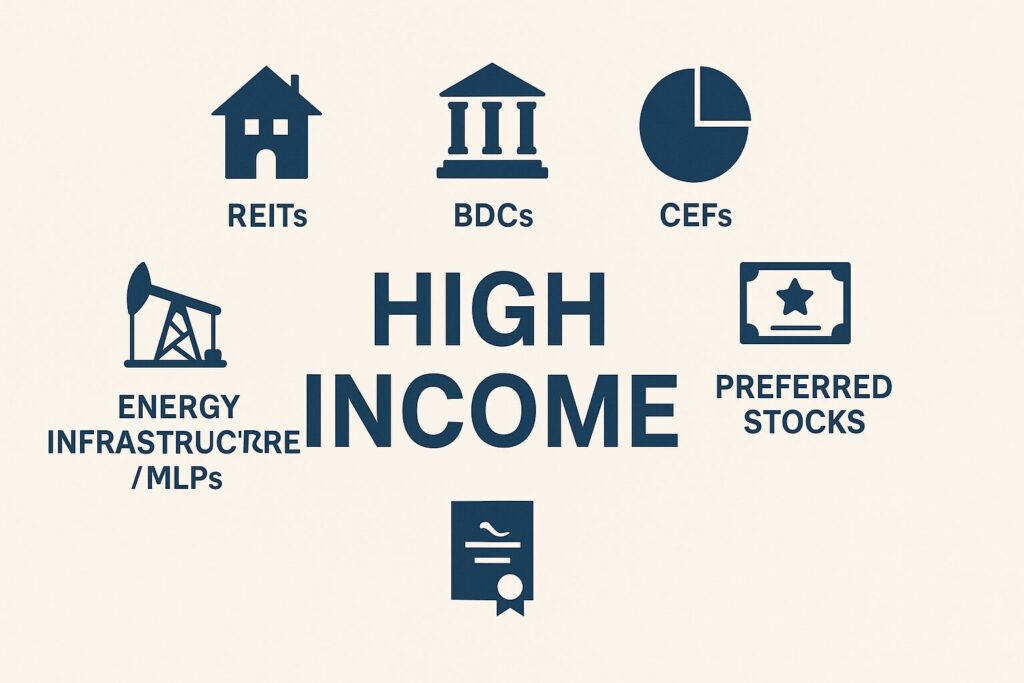
Steady Income from Conservative Investments That Yield 6–10%
When you’re retired, income isn’t just nice to have—it’s essential. You’ve worked hard, saved diligently, and now you want your money to pay you back with consistent, worry-free cash flow.
But with interest rates rising, inflation chipping away at purchasing power, and the stock market acting like a rollercoaster, many retirees are asking:
“Where can I get reliable income without taking on too much risk?”
The good news is: you don’t need to chase risky investments or time the market. There are conservative, income-focused investments that have stood the test of time—delivering 6% to 10% yields without sleepless nights.
In this post, we’ll spotlight 5 of the most dependable high-yield investments for retirees—the same types of investments discussed in detail in my book, 9% Retirement Paycheck.
🏡 1. Real Estate Investment Trusts (REITs)
What they are:
REITs are companies that own income-producing real estate like apartment complexes, medical buildings, storage units, and shopping centers. They’re required by law to pay out 90% of their taxable income to shareholders.
Why retirees like them:
- Monthly or quarterly dividend payments
- Diversification away from stocks and bonds
- Yields often in the 6–9% range for select REITs
- Tax advantages when held in IRAs or Roth accounts
Examples:
- Realty Income (O) – Known as “The Monthly Dividend Company”
- Rexford Industrial Realty (REXR) – Focused on e-commerce-driven industrial real estate
✅ REITs can give your portfolio a steady “rent check” without owning any property yourself.
🏦 2. Business Development Companies (BDCs)
What they are:
BDCs lend money to small and mid-sized businesses that can’t get traditional bank loans. In return, they earn high interest payments—which they pass along to shareholders.
Why retirees like them:
- Yields of 7–10%+, paid quarterly or even monthly
- Exposure to private credit markets
- Diversified income streams from hundreds of small businesses
Examples:
- Main Street Capital (MAIN) – A high-quality, conservative BDC with a monthly dividend
- PBDC (Prospect Capital) – Offers high yield and diversification
✅ BDCs turn lending into income—and you become the bank.
💰 3. Closed-End Funds (CEFs)
What they are:
CEFs are professionally managed portfolios of stocks, bonds, or credit instruments that trade like stocks. Unlike mutual funds, they have a fixed number of shares and often trade at a discount to their net asset value (NAV).
Why retirees like them:
- Consistently high yields (often 7–10% or more)
- Access to professional management and hard-to-reach markets
- Monthly or quarterly income
Examples:
- PIMCO Dynamic Income Fund (PDI) – Invests in mortgage-backed and corporate bonds
- Nuveen Floating Rate Income Fund (JFR) – Targets senior loans with floating interest rates
✅ CEFs can boost income without increasing your risk—if you choose the right ones.
🛢️ 4. Energy Infrastructure / MLPs
What they are:
Master Limited Partnerships (MLPs) are pipeline companies that transport oil and natural gas. Because they operate like toll roads, they collect steady fees regardless of energy prices.
Why retirees like them:
- Stable cash flows and high distributions
- Yields of 6–9%
- Inflation protection through long-term contracts
- Strong long-term track records
Examples:
- Enterprise Products Partners (EPD) – A large, stable MLP with a long history of increases
- MPLX LP (MPLX) – Operates critical U.S. pipeline and storage infrastructure
✅ MLPs and energy infrastructure can provide “hard asset” income with inflation resistance.
📈 5. Preferred Stocks
What they are:
Preferred stocks are hybrid securities that act like bonds but trade like stocks. They typically pay fixed dividends and have priority over common stock in the event of liquidation.
Why retirees like them:
- Stable yields of 6–8%
- Less volatile than common stocks
- Ideal for income-seekers who want predictable payouts
Examples:
- PSA.PG (Public Storage Preferred G) – A well-known preferred share with reliable income
- PFF (iShares Preferred and Income Securities ETF) – An ETF of diversified preferred shares
✅ Preferred stocks let you “sit above the crowd” when collecting dividends.
🎯 Which One Is Right for You?
Each of these high-yield investments offers something unique:
| Investment Type | Typical Yield | Best For |
|---|---|---|
| REITs | 4–8% | Real estate exposure & monthly income |
| BDCs | 7–10% | Credit income & diversification |
| Closed-End Funds (CEFs) | 7–10% | Boosting income with professional help |
| MLPs / Pipelines | 6–9% | Inflation protection & steady cash flow |
| Preferred Stocks | 6–8% | Fixed-income alternatives |
You don’t have to pick just one. Many retirees use a blend of these investments to create a diversified, reliable income stream that covers monthly expenses and keeps pace with inflation.
👵 Real-Life Snapshot: Ed and Linda’s 9% Retirement Paycheck
Ed and Linda, both in their mid-70s, live off Social Security and a $500,000 investment portfolio.
They’ve built a reliable income stream by investing in:
- 25% REITs
- 20% BDCs
- 20% Closed-End Funds
- 20% Preferred Stocks
- 15% MLPs
Their average portfolio yield? Just over 9%.
“We don’t worry about the market like we used to,” says Linda. “Every month we see the dividends come in—and that’s all we need.”
🧩 Final Thought: Steady Income = Peace of Mind
You don’t need to chase risky stocks or guess what the Fed will do next. With conservative, high-yield investments, you can create your own reliable paycheck in retirement—month after month, year after year.
And when you know your income is secure, you can spend more time doing what really matters: enjoying your retirement.
📘 This post is adapted from my book:
9% Retirement Paycheck: How to Generate Steady, Worry-Free Income for Life
Available now at Amazon.com in paperback and eBook formats.
Disclaimer: This post is for informational and educational purposes only and is not intended as investment, tax, or financial advice. Please consult a licensed financial advisor before making investment decisions. Investing involves risk, and past performance is not indicative of future results.